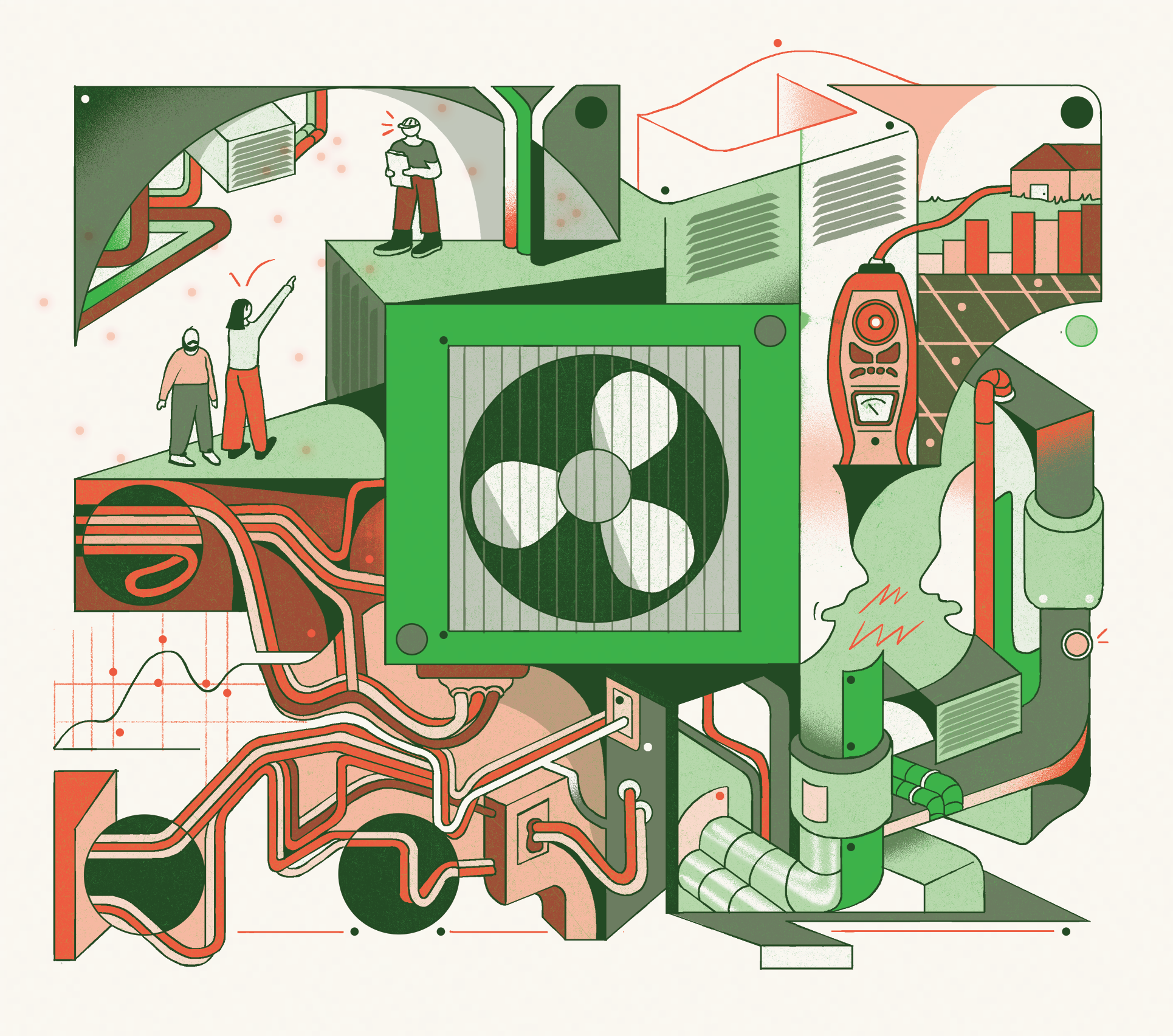“It just knows.”
The senior HVAC technician I’d been working with on a home remodel answered with the conviction of decades of experience. I, on the other hand, was less certain. How could a new furnace “know” that it had just been connected to a 20-year-old air conditioner (from a competing brand), somehow read that unit’s cooling capacity, and then calibrate its own output to the precisely required airflow? In a bid to reconcile the reading on my manometer with the tech’s supposed savvy, I asked whether he was certain. He was, he told me, quite positive. “Tell you what,” he said. “If I’m wrong, then there’s probably 200 air conditioners in Princeton with bad airflow. And that can’t be right.”
I began working in construction in 1991. At the time of the 2008 housing crisis, I ran a home remodeling business with my brother. Both of us were well studied in energy efficiency and resilient design. When the bottom fell out of the housing market, we quickly transitioned our business into air sealing and insulation work. The New Jersey Home Performance with Energy Star program was slated to receive a sizable infusion of federal funding, and so while residential remodeling might collapse, most homes in New Jersey would be eligible to receive rebates for implementing energy-saving measures. I took classes and became certified in heating, ventilation and air-conditioning, and was responsible for overseeing the HVAC work we subcontracted on our projects.
I’d already had — for years leading up to the housing crash — nagging concerns about the suboptimal HVAC performance on our projects. In spite of paying premiums to local, supposedly expert subcontractors, the homes we worked in were frequently plagued by problems: high humidity, lots of noise, room-to-room temperature differences, and some full mechanical failures. HVAC training classes were partly a way to boost revenue, but I also figured that having that expertise would allow me to help our HVAC subcontractors make minor tweaks to greatly improve their installations. And that’s how I found myself in a Princeton basement reading a digital display that suggested the furnace, in fact, didn’t know it had been connected to anything. It had to be told.
I soon came to realize that there were probably many more than 200 air conditioners with bad airflow in Princeton.
The importance of HVAC
The importance of indoor air quality is no longer overlooked. Improving indoor air quality through interventions like adequate ventilation, proper filtration, and ultraviolet germicidal irradiation in public buildings could conceivably cut the transmission of respiratory illness by up to two thirds. But there are bottlenecks to the mass deployment of these new technologies. A 1Day Sooner/Rethink Priorities report lists three: a lack of clear standards, the cost of implementation, and difficulty changing regulation and public attitudes.
I’d like to add a fourth: the workforce that will be tasked with installing them.
Our national HVAC crisis runs much deeper than a few bad contractors in Princeton, New Jersey. All the construction trades suffer from a shortage of skilled labor, but the situation in HVAC may be uniquely bad: Not only are there not enough workers, the workers we have often — I will suggest — aren’t capable of fulfilling basic work requirements. I regularly watch technicians struggle with routine maintenance that demands far less technical savvy than the proper installation of ultraviolet germicidal irradiation.
And our inadequately trained and skilled HVAC workforce is already proving itself a roadblock for another key technology: heat pumps. Replacing combustion furnaces and boilers with electric heat pumps is a critical step toward reducing carbon emissions. But there’s a catch: The refrigerant most commonly used in heat pumps, a formula called R410a, is itself a potent greenhouse gas. Systems installed according to industry standards very rarely leak. But in practice, HVAC technicians frequently — at the very minimum 10% of the time, though estimates vary widely — fail to follow these standards. Many of the gains of electrification are being clawed back by unexpectedly high refrigerant leak rates as a result.
New technologies have the potential to make daily life cleaner, safer, and greener — but only if we have technicians capable of installing them.
How bad is it?
That single instance of an unprogrammed fan wasn’t sufficient to change my view of the HVAC industry, but the decade that followed certainly was.
Take, for example, New Jersey’s stringent ceiling on air duct leakage: Leaky ducts can reduce energy efficiency, draw in allergens and other pollutants, and result in uneven cooling in a home. In my work with a wide variety of HVAC subcontractors, nearly everyone was adamant in their ability to meet these standards. But on-site? They almost universally failed all forms of objective testing. In my own remodeling work, the situation grew so bad that my brother and I were forced to bring the work of duct sealing — the simple act of painting liquid mastic on fittings — in-house, rather than rely on contractors.
To this day, no contractor I’ve worked with has passed a leakage test on the first attempt.
It’s hard to say how widespread this is, because no one is tracking these failures. Residential duct leakage testing remains a quagmire of faked numbers, unwilling field testers, and code officials willing to accept any scrap of paper validation to keep projects from sitting idle or forcing duct system tear-outs. I gradually learned that such competence and honesty problems had long plagued the HVAC industry.
For example, in order to determine the proper size for an HVAC system, building codes mandate accurate heat load/loss calculations, a process referred to as a “Manual J.”
There are templates that can be used to speed up the process, but accurate measurements must be taken for each house individually, as no template can capture all salient variables. Simply rotating a house from north to west, for example, will often change cooling demand by 20%. A friend, a technical manager of a clean energy program, estimated that, despite decades of investment in training and compliance checks, over 90% of Manual Js reviewed by his program had significant errors. Some of these were obvious due to internal inconsistency (imagine, for example, a contractor listing a duct load on a home heating system that uses water, not air). Others, such as home size and orientation, could be easily contradicted by public information on Zillow or Google Maps. And this is probably a widespread practice.
One of the largest HVAC companies in New Jersey had a very effective system to streamline — and scam — this method. Rather than take measurements of each house, they would simply install whatever equipment the salesperson deemed suitable, and then after the fact submit a Manual J that matched the installed size. They did this by keeping on hand Manual J files sorted according to their capacity — 1 ton, 2 ton, etc. — and then renaming each one to fit the job site address. They might still be doing it if the company’s Manual J administrator hadn’t gone on vacation. The temporary replacement forgot to rename the files — exposing a practice by which the company had submitted the same handful of designs for thousands of homes.
And this is hardly a problem restricted to New Jersey. In the early aughts an engineer named John Proctor created CheckMe!, a diagnostic tool that can evaluate whether technicians tasked with adjusting AC system refrigerant levels, airflow, and duct leakage have done so correctly. In a study of residential and commercial HVAC systems in California, “What Can 13,000 Air Conditioners Tell Us?,” 57% were in need of charge repair and 21% had inadequate airflow.
It turns out, 13,000 air conditioners can tell us that systemic HVAC installation or operation errors are likely widespread across the country.
This was the state of affairs when indoor air quality rose to national prominence. To reopen schools during the COVID-19 pandemic, public health officials asked school managers across the country to upgrade their central ducted HVAC system filters to a minimum efficiency reporting value of 13 or higher — MERV ratings run from 1 to 16, with higher levels more effective in filtering particles — and set the fans to run continuously. Higher-rated filters exert increased load on HVAC systems via air flow resistance: Imagine breathing through a cheesecloth compared to an N95. In most cases, the slight increase in pressure caused by a higher-quality filter is trivial.
However, a sizable number of building managers and technicians reported that these systems couldn’t handle the pressure of a filter upgrade. This statement was largely taken at face value by public health officials and parents. But as far as I can tell, it was very rarely true. In every instance I’m aware of, neither the HVAC systems’ specifications nor their actual pressure readings showed that they couldn’t be upgraded, and in the vast majority of cases, the people making this claim didn’t possess the tools or knowledge to measure system pressure in the first place. In the rare instances where higher density filters can be problematic, it’s usually simple to offset the increase in pressure by decreasing it elsewhere by, for example, adjusting dampers or registers in the ductwork to balance the system. In other words, the default position should be that resistance to filter upgrades is almost entirely rooted in a combination of obstinance and ignorance.
And for upgraded filters to be effective, HVAC systems need to be fully operative in the first place. My anecdotal experience suggests they’re not. Well into the pandemic, a friend who coaches at a Princeton boarding school approached me with a diagnostic and repair problem. During high-occupancy sports events, water pooled on the floors of the school’s gymnasiums. He was forced to pay assistant coaches to hurriedly wipe the floors with towels during breaks in the games. From a ventilation standpoint this usually indicates catastrophic failure. It means that occupant breathing and sweating is causing massive humidity spikes, and this humidity isn’t being ventilated from the building.
I discovered that two of the gymnasiums’ three extraction fans weren’t operating, and the third wasn’t synchronized to times when the gyms were at high occupancy. Practically speaking, the ventilation system was almost entirely inoperable. I repaired one fan simply by deleting a fault code that had likely locked out operation for the entire pandemic. Another needed to be replaced, which is typically a several-hour job. The final fan just needed to be manually turned on by pressing a button at the start of games. If a school with students from some of the world’s most elite families couldn’t fix the most basic problems in their HVAC systems, what does that imply for other institutions?
How we got here
It’s hard to say what led to the current state of the HVAC industry, and my comments here are anecdotal and speculative. That said, my experience suggests that it is all too common for contractors to convincingly lie about their capacity to perform a job, or — worse — report having performed jobs they haven’t even attempted.
Equipment sophistication has vastly increased over the past few decades, but the quality of the workforce hasn’t risen to match the increased demands. During the pandemic, a common refrain among public health experts was that technicians simply needed more training to bring buildings up to public health standards. But the improvements and repairs required to upgrade HVAC systems for pandemic prevention are, by and large, covered in basic certification. Technicians may of course need better training, but my experience suggests that cultural changes in the industry will be necessary for this to have real impact.
Fraud seems unfortunately widespread. Many technicians are paid a “spiff” on items they upsell as part of routine service and maintenance calls. In extreme cases, this leads to red-tag scams, in which technicians falsely claim that heating appliances are irreparably broken in an effort to sell full system replacements. I’ve been directly involved in consulting with several clients in red-tag scams, and dozens of separate instances where technicians have falsely claimed a system is beyond repair instead of making a trivially easy part replacement.
Here again we lack data, but it’s reasonable to assume such legerdemain is not difficult to uncover. In 2012, NBC’s Dateline ran a sting operation in which a host of HVAC contractors were called to fix what appeared to be a failing AC unit, but was in fact a system that had a (visible and obvious) clipped wire. At just one house, numerous contractors from surrounding towns quoted repairs or full replacements costing orders of magnitude more than simply fixing the wire.
It’s already difficult for non-experts to tell when HVAC technicians are lying, and the challenge is exacerbated by a workforce culture that lacks norms of honesty. I’ve listened to technicians offer diagnoses that range from slightly disconnected from truth to in blatant violation of physical laws.
At this moment, policing the entire industry is infeasible. One hope is that manufacturers of equipment could be incentivized to play backstop. After all, many units come with five- to 10-year warranties. And indeed, industry manufacturers report that most major parts returned and bench-tested by them under warranty are still operational. Nevertheless, more often than not they issue refunds.
And where true mechanical issues do exist, equipment manufacturers have little incentive to address problems: Because contractors are the ones who buy equipment, they, rather than end users, are seen as the customers. Manufacturers are thus hesitant to reveal flaws to people whose homes contain their equipment, even when they have good evidence of widespread problems.
Better technologies can provide overlapping systems of quality control and end-user protection, but these have low uptake among contractors. Remember the misprogrammed fan? Manufacturers do have advanced thermostats called “communicating controls” that are capable of recognizing the same-brand equipment that they’ve been connected to and can automatically select the correct airflow. While they’re imperfect, they’re much better than the default of widespread incorrect airflow. But at over $1,000, they are rarely sold because they’re viewed as a luxury rather than an error avoidance tool. And since they primarily communicate to technicians, not end users, we end up in a situation where HVAC contractors are the primary salespeople for devices designed to protect clients from their own incompetence. It’s a tough sell.
What we can do
In order to fix these problems, occupants need clear, verifiable information about how their HVAC systems work. The more complex and opaque a system is, the more likely it is that technicians will make mistakes in installing and repairing it — and the easier it is for them to lie. Measuring airflow might seem like a simple task for an HVAC technician, but in fact it’s widely misunderstood. Most technicians won’t have the training or tools to quantify airflow. And in an industry in which technicians and managers routinely lie, asking whether an individual or company can perform a task has the potential to select for lying instead of competence.
In the absence of industry wide norms change and regulation, there are interventions that can put objective metrics into the hands of end users — and thereby create feedback loops that create consumer checks on the industry. Imagine the gas mileage in your car abruptly plummets. You may not be able to diagnose the issue, but you’ll have immediate feedback over whether the mechanic has actually fixed the problem the next time you drive. These proposals won’t be enough to better regulate the HVAC industry on their own: People need to use them, and agencies and unions will need to adopt or support them in some form, but they represent a first step.
The first is the use of carbon dioxide monitors as a proxy for indoor air quality generally, and respiratory virus transmission risk in particular. The risk of infection within indoor settings scales with excess CO2, and in a room with inadequate ventilation, CO2 increases over time. Public monitors can thereby work as proxies for adequate ventilation systems, and is an effective way to monitor the safety of rooms over time, as well as to diagnose room-to-room variations in air quality.
While handheld CO2 monitors have become somewhat widespread, to date visible public displays have gained very little traction. In part, this is because it’s difficult to figure out what CO2 level to target in rooms with both ventilation and air filters — as filters can provide sufficient protection where adequate ventilation isn’t possible. This could probably be addressed by clearly labeling the clean air delivery rate of standalone filters in a room. Standalone filters are superior to central ones because laypeople aren’t readily able to verify central system filtration rates. However, with improvements to the display of clean air delivery rate on freestanding filters, it would be fairly simple for a sophisticated layperson to roughly calculate the filtered air exchanges.
We also need ways to improve the transparency of necessary HVAC work. Technicians should geotag pictures of measured performance and diagnostics, and these should be publicly available, either on a company’s website or — if regulation were to go so far — some sort of public repository. Claims regarding equipment parameters and limitations should include geotagged photos of nameplates and highlighted sections from installation manuals. Only a small number of contractors currently offer these services. Consumers should choose those that do.
Finally, we can push for adoption of improved or less failure-prone technology. Adoption of communicating controls has the potential to rectify programming errors, but they’re unlikely to take off unless consumers demand them.
An earlier version of this article incorrectly described MERV ratings as running from 1-20.




